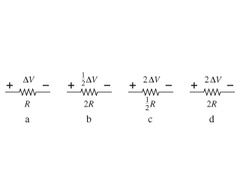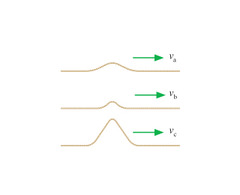
A wave pulse travels along a stretched string at a speed of 200 cm/s .
What will be the speed if the string’s TENSION is doubled?
Eqn: v = ? (T/ µ)
If the Tension in doubled, the speed will increase by a factor of ?2.
200 cm/s × ?2 = 283 cm/s
A wave pulse travels along a stretched string at a speed of 200 cm/s .
What will be the speed if the string’s mass is quadrupled (but its length is unchanged)?
Eqn: v = ? (T/ µ) where µ = m/L
If the mass is quadrupled, the speed will decrease by a factor of ?(1/4).
200 cm/s × ?(1/4) = 100 cm/s
A wave pulse travels along a stretched string at a speed of 200 cm/s .
What will be the speed if the string’s length is quadrupled (but its mass is unchanged)?
Eqn: v = ? (T/ µ) where µ = m/L
If the length is quadrupled, the speed will increase by a factor of ?4.
200 cm/s × ?4 = 400 cm/s

The figure is a history graph showing the displacement as a function of time at one point on a string.
Did the displacement at this point reach its maximum of 2 mm before or after the interval of time when the displacement was a constant 1 mm?
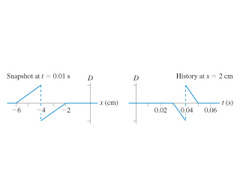
The figure shows a snapshot graph and a history graph for a wave pulse on a stretched string. They describe the same wave from two perspectives.
In which direction is the wave traveling and what is the speed of the wave?
From the history graph, the leading edge is pointed to the right, so the wave is traveling to the right.
From the snapshot graph, |-2cm/0.01s| = 200 cm/s.
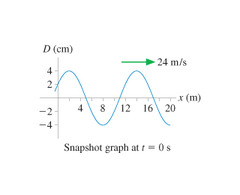
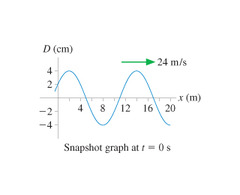
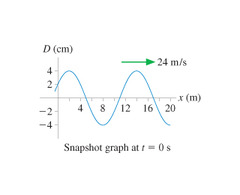
So ƒ = v/?.ƒ = (24m/s)/(12m) = 2.0 s??, or 2.0 Hz
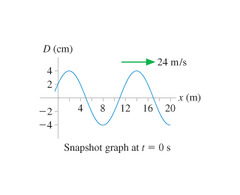
From the graph, t=0, A=4.0cm, D=2.0cm.2.0cm = 4.0cm sin ( ?(0) + ?)
? = arcsin (2.0cm/4.0cm) = ?/6 = .524 rad

The figure is a snapshot graph of a sinusoidal wave at t=1.0s.
What is the phase constant of this wave?
D = Asin(kx – ?)
where A amplitude, k constant, and ? phase
When x = 0, observe D = A.
That means that sin(kx – ?) = 1.
Since we’re looking where x = 0, sin(-?) = 1.
Therefore ? = -?/2.

The figure shows the wave fronts of a circular wave.
What is the phase difference between points A and B?
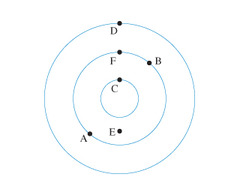
The figure shows the wave fronts of a circular wave.
What is the phase difference between points C and D?
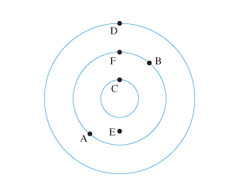
The figure shows the wave fronts of a circular wave.
What is the phase difference between points E and F?
v = ?ƒ ( assume v= 1m/s)
?a = (1/100)
?b = (1/1000)
?c = (1/10000)
So, ?a>?b>?c
??ƒ?/??ƒ? = 3.00. Frequency does not change with the medium. So, ƒ?=ƒ?. That , means the new wavelength ??/?? = 3.00, and the new frequency ƒ?/ƒ? = 1.00.
Sound wave B delivers 10 J of energy in 5 s.
Sound wave C delivers 2 mJ of energy in 1 ms.Rank in order, from largest to smallest, the sound powers Pa, Pb, and Pc of these three sound waves.
Energy (J) = Power (W) * Time (s) (E=Pt)
Power (W) = Energy (J) / Time (s)
Pa = 2J/2s = 1W
Pb = 10J/5s = 2W
Pc = 2×10?³ J / 1×10?³ s = 2W
So, Pb=Pc>Pa

The figure is a history graph at x=0m of a wave traveling in the positive x-direction at 4.0 m/s.
What is the wavelength?
From the graph, v = 4.0 m/s.T = 1/ƒ, so ƒ=1/T. T = 0.25s – 0.05s = 0.2s
ƒ = 1/0.2s = 5 Hz
v = ?ƒ, so ? = v/ƒ.
? = 4.0 m/s / 5 Hz = 0.8m

The figure shows the displacement of a standing sound wave in a 32-cm-long horizontal tube of air open at both ends.
What mode (m-value) is this?
Are the air molecules moving horizontally or vertically?
m = 2
The air molecules are moving horizontally.
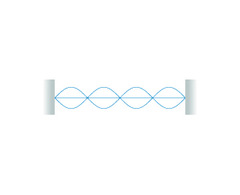
The figure shows a standing wave oscillating on a string at frequency f0.
What mode (m-value) is this?
How many antinodes will there be if the frequency is increased to 6f0?
m = 4
When frequency is changed to 6ƒ?, there will be 24 antinodes. (6*4)
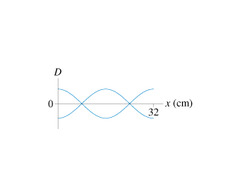
The figure shows the displacement of a standing sound wave in a 32-cm-long horizontal tube of air open at both ends.
At what distances from the left end of the tube does the air pressure oscillate with maximum amplitude?
l= 8,24 cm.
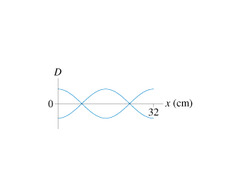
The figure shows the displacement of a standing sound wave in a 32-cm-long horizontal tube of air open at both ends.
At what distances from the left end of the tube do the molecules oscillate with maximum amplitude?
An organ pipe is tuned to exactly 384 Hz when the room temperature is 20?C.
If the room temperature later increases to 22 ?C, does the pipe’s frequency increase, decrease, or stay the same?
In music, two notes are said to be an octave apart when one note is exactly twice the frequency of the other. Suppose you have a guitar string playing frequency f0.
To increase the frequency by 1 octave(s), to 2f0, by what factor would you have to increase the tension?
ƒ = (1/2L) × ?(T/µ)
2ƒ = (1/2L) × 2?(T/µ)
2ƒ = (1/2L) × ?(2²T/µ)
2ƒ = (1/2L) × ?(4T/µ)
To increase the frequency by 1 octave(s), to 2f0, you would increase the tension by a factor of 4.
In music, two notes are said to be an octave apart when one note is exactly twice the frequency of the other. Suppose you have a guitar string playing frequency f0.
To increase the frequency by 1 octave(s), to 2f0, by what factor would you have to decrease the length?
ƒ = (1/2L) × ?(T/µ)
2ƒ = 2(1/2L) × ?(T/µ)
You would decrease the length by a factor of 2.

The figure shows the circular waves emitted by two in-phase sources.
Are points a, b, and c points of maximum constructive interference or perfect destructive interference?
B = Destructive Interference

Ic;Ia=Id;Ib
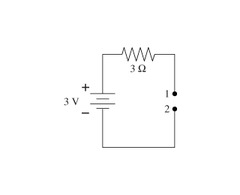
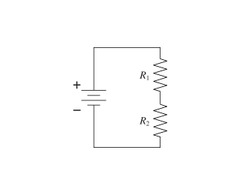
The circuit of the figure(Figure 1) has two resistors, with R1;R2.
Which of the two resistors dissipates the larger amount of power?
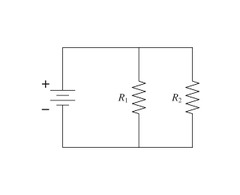
The circuit of the figure(Figure 1) has two resistors, with R1;R2.
Which of the two resistors dissipates the larger amount of power?
P=?V²/R
Pc;Pd;Pa;Pb
A battery with internal resistance r is connected to a load resistance R.
If R is increased, does the terminal voltage of the battery increase, decrease, or stay the same?

Initially bulbs A and B in the figure(Figure 1) are glowing.
What happens to bulb A if the switch is closed? Does it get brighter, stay the same, get dimmer, or go out?
What happens to bulb B if the switch is closed? Does it get brighter, stay the same, get dimmer, or go out?
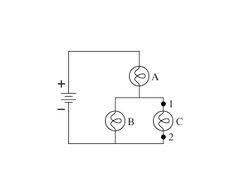
Bulbs A, B, and C in the figure(Figure 1) are identical, and all are glowing.
Rank in order, from most to least, the brightnesses of the three bulbs.
C and B are the same brightness.
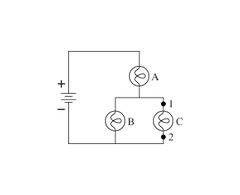



Bulbs A and B in the figure(Figure 1) are identical, and both are glowing. Bulb B is removed from its socket.
Does the potential difference ?V12 between points 1 and 2 increase, stay the same, decrease, or become zero?

Bulbs A and B in the figure(Figure 1) are identical, and both are glowing.
What happens to bulb A when the switch is closed? Does its brightness increase, stay the same, decrease, or go out?
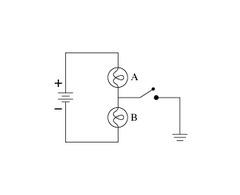
Bulbs A and B in the figure(Figure 1) are identical, and both are glowing.
What happens to bulb B when the switch is closed? Does its brightness increase, stay the same, decrease, or go out?

The figure(Figure 1) shows the voltage as a function of time of a capacitor as it is discharged (separately) through three different resistors.
Rank in order, from largest to smallest, the values of the resistances R1 toR3
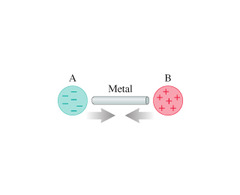
The two oppositely charged metal spheres in the figure have equal quantities of charge. They are brought into contact with a neutral metal rod.
What is the final charge state of each sphere and of the rod?
Metal sphere A in the figure has 4 units of negative charge and metal sphere B has 2 units of positive charge. The two spheres are brought into contact.
What is the final charge state of each sphere?
qA = -1
qB = -1
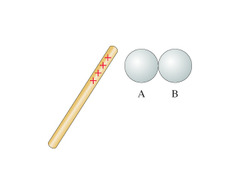
Metal spheres A and B in the figure are initially neutral and are touching. A positively charged rod is brought near A, but not touching.
Is A now positive, negative, or neutral?
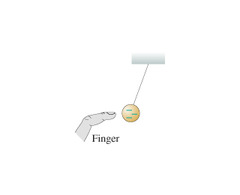
If you bring your finger near a lightweight, negatively charged hanging ball, the ball swings over toward your finger as shown in the figure.
Explain this.
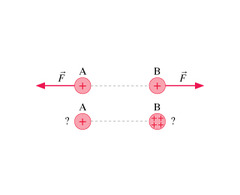
Charges A and B in the figure are equal. Each charge exerts a force on the other of magnitude F. Suppose the charge of B is increased by a factor of 4, but everything else is unchanged.
In terms of F, what is the magnitude of the force on A?
In terms of F, what is the magnitude of the force on B?
4F on A
What is the field strength if the distance from the point charge is doubled?
What is the field strength if the distance from the point charge is halved?
Halved – 12000 N/C
The electric force on a charged particle in an electric field is F.
What will be the force if the particle’s charge is tripled and the electric field strength is halved?
Balls B, C, and D are attracted to ball A.
Balls B and D have no effect on each other.
Ball B is attracted to ball C.
What are the charge states (glass, plastic, or neutral) of balls A, B, C, and D?
A – Plastic
B – Neutral
C – Glass
D – Neutral
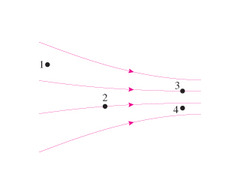
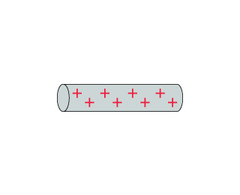
A small segment of wire in the figure(Figure 1) contains 13 nC of charge.
The segment is shrunk to one-third of its original length. What is the ratio ?f/?i, where ?i and ?f are the initial and final linear charge densities?
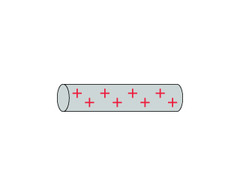
A small segment of wire in the figure(Figure 1) contains 13 nC of charge.
A proton is very far from the wire. What is the ratio Ff/Fi of the electric force on the proton after the segment is shrunk to the force before the segment was shrunk?
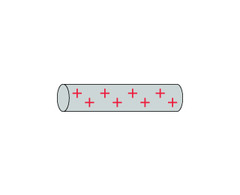
A small segment of wire in the figure(Figure 1) contains 13 nC of charge.
Suppose the original segment of wire is stretched to 15 times its original length. How much charge must be added to the wire to keep the linear charge density unchanged?
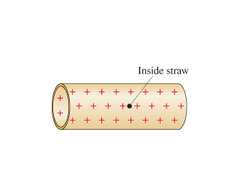
The hollow soda straw in the figure(Figure 1) is uniformly charged.
What is the electric field at the center (inside) of the straw?
An electron experiences a force of magnitude F when it is 2 cm from a very long, charged wire with linear charge density ?.
If the charge density is doubled, at what distance from the wire will a proton experience a force of the same magnitude F?
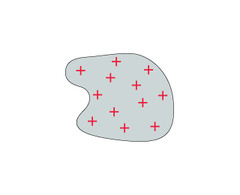
The irregularly shaped area of charge in the figure(Figure 1) has surface charge density ?i. Each dimension (x and y) of the area is reduced by a factor of 3.163.
What is the ratio ?f/?i, where ?f is the final surface charge density?
An electron is very far from the area. What is the ratio Ff/Fi of the electric force on the electron after the area is reduced to the force before the area was reduced?
?f/?i = 10
Ff/Fi = 1
A circular disk has surface charge density 20 nC/cm^2 .
What will the surface charge density be if the radius of the disk is doubled?
A sphere of radius R has charge Q. The electric field strength at distance r>R is Ei.
What is the ratio Ef/Ei of the final to initial electric field strengths if Q is halved?
A sphere of radius R has charge Q. The electric field strength at distance r>R is Ei.
What is the ratio Ef/Ei of the final to initial electric field strengths if R is halved?
A sphere of radius R has charge Q. The electric field strength at distance r>R is Ei.
What is the ratio Ef/Ei of the final to initial electric field strengths if r is halved (but is still >R)?
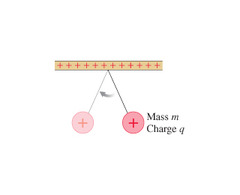
The ball in the figure(Figure 1) is suspended from a large, uniformly charged positive plate. It swings with period T.
If the ball is discharged, will the period increase, decrease, or stay the same?
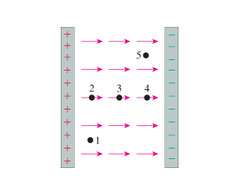
A parallel-plate capacitor consists of two square plates, size L×L, separated by distance d. The plates are given charge ±Q.
What is the ratio Ef/Ei of the final to initial electric field strengths if Q is doubled?
A parallel-plate capacitor consists of two square plates, size L×L, separated by distance d. The plates are given charge ±Q.
What is the ratio Ef/Ei of the final to initial electric field strengths if L is doubled?
A parallel-plate capacitor consists of two square plates, size L×L, separated by distance d. The plates are given charge ±Q.
What is the ratio Ef/Ei of the final to initial electric field strengths if d is doubled?

A small object is released in the center of the capacitor in the figure(Figure 1) . For each situation, does the object move to the right, to the left, or remain in place? If it moves, does it accelerate or move at constant speed?
A positive object is released from rest.
A neutral but polarizable object is released from rest.
A negative object is released from rest.
Positive – Accelerates to the right.
Neutral – Remains in Place
Negative – Accelerates to the left
A proton and an electron are released from rest in the center of a capacitor.
Is the force ratio Fp/Fe greater than 1, less than 1, or equal to 1?
Is the acceleration ratio ap/ae greater than 1, less than 1, or equal to 1?
Fp/Fe = 1
ap/ae <1
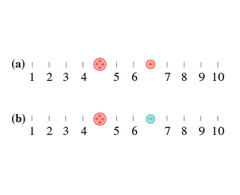
Two pairs of charges are shown in (Figure 1)
At which point or points is the electric field zero in figure (a)?
At which point or points is the electric field zero in figure (b)?
A – 6
B – 9
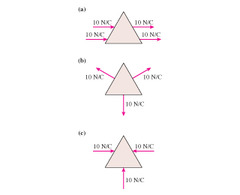
The figure(Figure 1) shows cross sections of three-dimensional closed surfaces. They have a flat top and bottom surface above and below the plane of the page. However, the electric field is everywhere parallel to the page, so there is no flux through the top or bottom surface. The electric field is uniform over each face of the surface
For each figure, does the surface enclose a net positive charge, a net negative charge, or no net charge?
(B) Net positive Charge
(C) Net negative charge
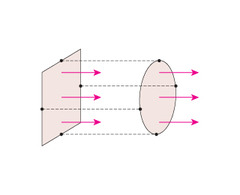
The square and circle in the figure(Figure 1) are in the same uniform field. The diameter of the circle equals the edge length of the square.
Is ?square larger than, smaller than, or equal to ?circle?
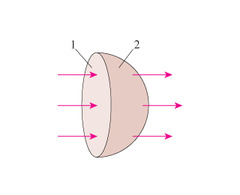
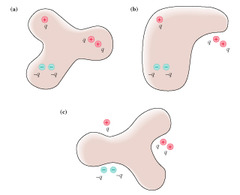
(b) = -1
(c) = 0

B = -4
C= 0
D = 3
E=0
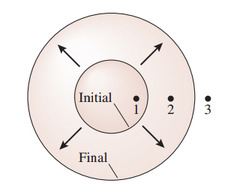
Does the electric field strength at each point increase, decrease, or stay the same?
1 stays the same
2 decreases
3 stays the same

Student 1: The fluxes through spheres A and B are equal because they enclose equal charges.
Student 2: But the electric field on sphere B is weaker than the electric field on sphere A. The flux depends on the electric field strength, so the flux through A is larger than the flux through B.
Student 3: I thought we learned that flux was about surface area. Sphere B is larger than sphere A, so I think the flux through B is larger than the flux through A.
Student 1: The fluxes through A and B are equal because the average radius is the same.
Student 2: I agree that the fluxes are equal, but that’s because they enclose equal charges.
Student 3: The electric field is not perpendicular to the surface for B, and that makes the flux through B less than the flux through A.
Student 4: I don’t think that Gauss’s law even applies to a situation like B, so we can’t compare the fluxes through A and .B

A small, metal sphere hangs by an insulating thread within the larger, hollow conducting sphere of the figure (Figure 1) . A conducting wire extends from the small sphere through, but not touching, a small hole in the hollow sphere. A charged rod is used to transfer positive charge to the protruding wire. After the charged rod has touched the wire and been removed, are the following surfaces positive, negative, or not charged?
The small sphere
the inner surface of the hollow sphere
the outer surface of the hollow sphere
negative
positive
An electron moves along the trajectory of the figure from i to f.
Does the electric potential energy increase, decrease, or stay the same?
Is the electron’s speed at f greater than, less than, or equal to its speed at i?
the speed at f is less than the speed at i
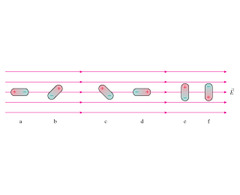
A capacitor with plates separated by distance d is charged to a potential difference ?VC. All wires and batteries are disconnected, then the two plates are pulled apart (with insulated handles) to a new separation of distance 2d.
Does the capacitor charge Q change as the separation increases?
Does the electric field strength E change as the separation increases?
Does the electric field strength E change as the separation increases
no
yes – by a factor of 2






